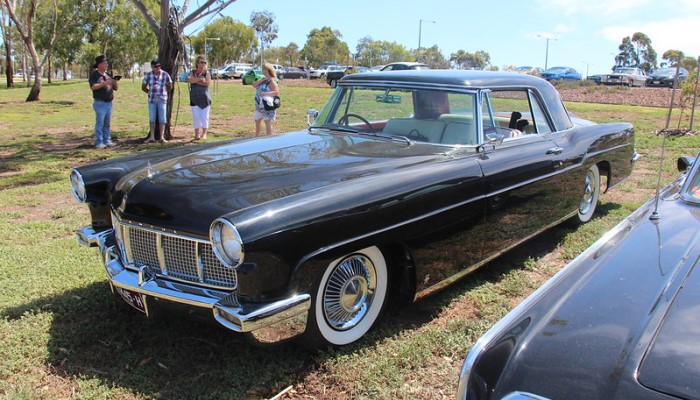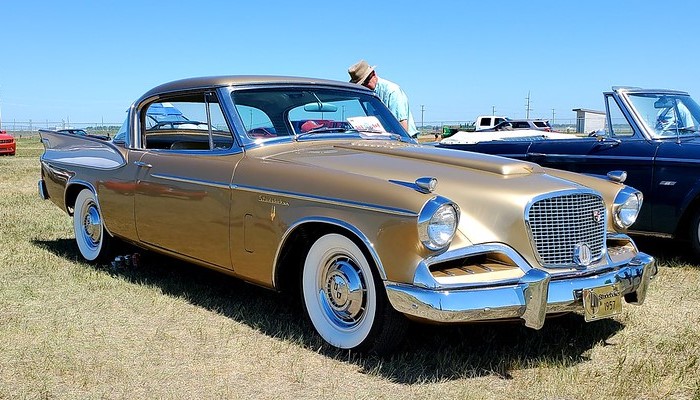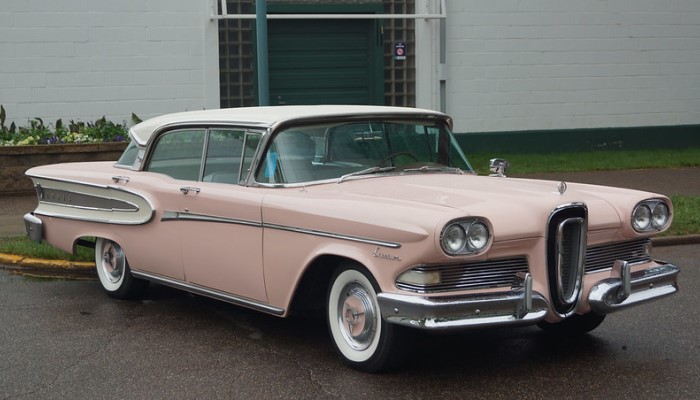Ford Fairlane 500 Skyliner
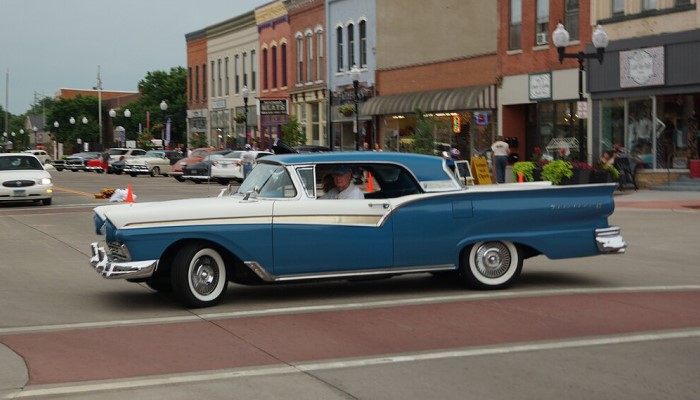
Photo: "1957 Ford Fairlane 500 Skyliner; Hasting, MN (43135595551)" by Greg Gjerdingen from Willmar, USA
Combination of Coupe and Convertible
Ever since the Model T era, Ford has mostly produced cars that were predestined for success. After World War II, the situation slowly began to change. With the arrival of Henry Ford II at the head of Ford in 1943, Ford began to work on its image thanks to a team of young engineers that Henry personally selected.
Thanks to the great success of the first post-war Ford, which appeared on the market in 1949, Ford also had the necessary finances to develop a new line of cars.
This was mostly related to the first Ford sports car on the American market (1955 Thunderbird) as well as the Continental division, which had only one model (Mark II), but with a price of even $9,000, it belonged to the very top of the auto industry.
Ford was also hard at work on another new division (the Edsel) that was to begin operations in 1958. However, the situation at Ford itself was quite calm, and the company did not plan any major experiments, but at any cost, it wanted an exclusive car that would improve the company's image.
Gil Spear, one of Ford's engineers at the Advanced Design Studio, came up with the idea of combining a coupe and a convertible in the early 1950s. Spear kept this idea to himself and, in his free time, began working on a car project that would have a metal roof that would lower into the trunk at the push of a button.
In this way, the customer could get a combination of coupe and convertible, and when the idea was finally presented, it did not take long for Ford's top managers to convince them for approval—Henry Ford immediately approved the $2 million budget.
This idea was certainly not new, and before the war, cars such as the Peugeot 402 and 601 and the Chrysler Airflow had the specified option, but it did not appear on any production model after the war. Chrysler started experimenting with this technology again in 1945, but after only one prototype, the project was shut down.
Project Development
Ford approved the project in 1953, and young engineer Ben Smith, who was brought in from GM that same year, had only 18 months to complete the project. Although Smith considered using hydraulics to raise and lower the roof, in the end the choice fell on an electric motor.
Unlike the mentioned French and American predecessors, Ford's car was supposed to have a fully automatic roof, which meant that the owner only had to sit down and press a button. This meant that the trunk had to open itself, and the roof, in one or two parts, came out of it and connected to the windshield.
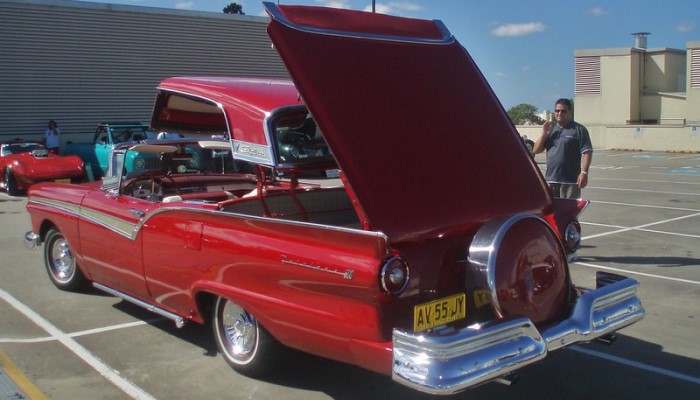
Photo: "1957 Ford Fairlane 500 Skyliner" by sv1ambo
Although this idea seemed simple on paper, Smith had to build nine different engines before choosing the one that worked best. The first prototype was finished at the end of 1953, and the 1952 Lincoln served as the base. A second prototype, also based on the Lincoln, was ready a year later, and Ford ran as many as 10,000 tests before the project got the green light for series production.
Interestingly, Ford planned to offer this option only on the Continental Mark II, but the price seemed too high. In other words, the Mark II already had a high price of $10,000, and the coupe-cabrio would add another $2,500, which would put the car on par with the Rolls-Royce. However, the Continental division was shut down in mid-1956, and at the last moment, a decision was made to give Ford this option.
Name Selection
In previous years, Ford had been working hard on a new model that was supposed to debut in 1957. This car was to be one of the greatest Fords in history and continue the success of the post-war models.
For the first time in its history, Ford offered two vehicle lengths: the smaller Custom and Custom 300, as well as the larger Fairlane and Fairlane 500. It was decided that the coupe-convertible would be part of the Fairlane 500 line, but slightly longer as well as heavier by as much as 225 kg (496 lb).
When choosing a name, Ford had as many as 120 different options, including the Liberator, Caprice, Spectacular, Hida-Top, and Telecoupe, but the choice ended up being the Skyliner, based on Ford's model from the early 1950s that had a glass roof.
Engine Options
The customer got three V8 engines as options: 272ci (4.6L) with 190 hp, 292ci (4.8L) with 212 hp, and 312ci (5.1L) with 245 hp and 270 hp. In the middle of 1957, the largest engine with a supercharger, which gave a final power of 300 hp, was also offered. These models are very rare today, and it is believed that only six examples survived.
All models had a choice of three manual and automatic transmission speeds. Ford demanded that the Skyliner be perfect, so this car was produced on a special strip far from the rest of the Fairlane line. The interest in this car was so great that even US President Dwight D. Eisenhower requested a copy that was produced just six weeks after Ford officially introduced the Skyliner.
Price, Sales and Development
With a starting price of $2,942, the Skyliner wasn't a cheap car, but it certainly was special. However, despite the large space on the front and back seats, the trunk space was minimal. The Skyliner had a special box in the trunk where the driver could put small things, which was located under the roof.
In case you had to remove the spare tire, you would first have to lift the roof and then remove the box. Despite the flaws mentioned, interest was high, so Ford sold 20,766 units in the first year.
In 1958, the entire Ford line received new design changes, and the Skyliner was among them. The biggest design change was the dual headlights, but Ford paid a lot of attention to the mechanics.
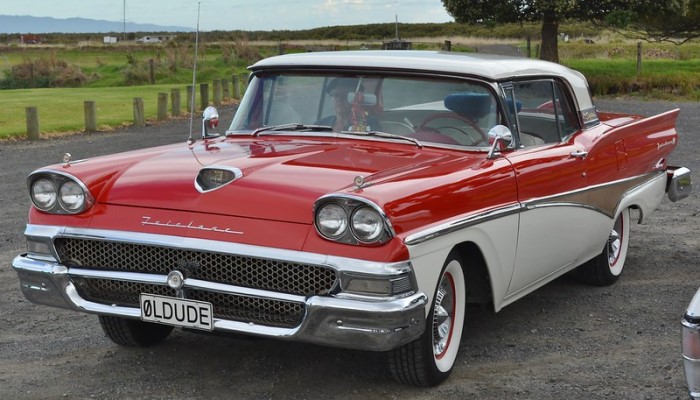
Photo: "1958 Ford Fairlane 500 'Skyliner'" by GPS 56
The supercharger was phased out, but the customer got a choice of two new engines: the 332ci (5.4L) with 265 hp and the 352ci (5.8L) with 300 hp. Unfortunately, Ford's design for 1958 did not prove popular with customers, and the recession played a big role.
With a starting price of $3,163, Ford sold 14,713 Skyliners in 1958. Although the Skyliner did not live up to expectations in 1958, when Ford introduced the 1959 lineup, this car was once again among them. The design was again new, and today it is considered one of the most beautiful Fords of all time.
By mid-year, the Galaxie replaced the Fairlane as Ford's best and most expensive model, and the Skyliner was moved into its lineup. When Smith was appointed president of Ford in Argentina in mid-1959, rumors started that Ford was ready to shut down production of this this car.
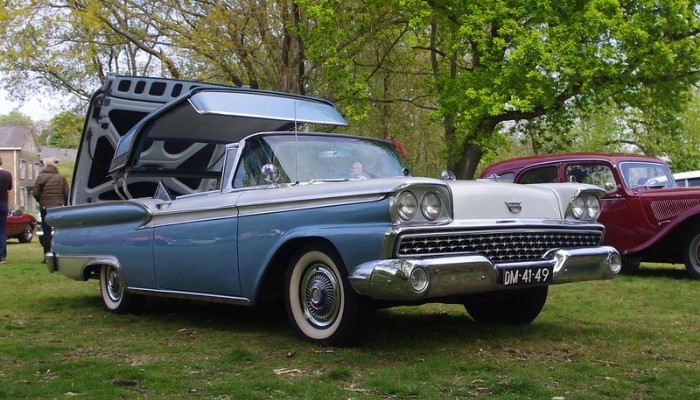
Photo: "1959 Ford Fairlane 500 Galaxie Skyliner" by Rutger van der Maar
When you add to that the sales of only 12,915 units in 1959, no one was surprised when the Skyliner did not find its way into Ford's lineup for 1960. There is evidence that Ford was planning a 1960 Skyliner, but the new car was heavier and lower, and the extra 225 kg (496 lb) would have hurt the car's performance.
Today's Market Value
Today, the Skyliner is one of the most prized Fords of the 1950s. Most of the 48,394 examples produced survive, and prices range from about $15,000 for a car in solid condition to over $150,000 for one of the six surviving 1957 supercharged models.
Although it was on the market for a very short time, the Skyliner still left a deep mark and also served as an inspiration to the famous 1961–1969 Lincoln Continental, which had the same option. So when you see a modern car today whose metal roof descends into the trunk, remember that it all started with the Skyliner.

Unique Car Zone Team
A group of several fans of everything that moves on four wheels, a few article creators, a couple of marketing strategists, designers, web developers, and lots of coffee.




